The Clever Method
John McCabe
I've chosen to call this method "clever" because the
opener calculates the likely position of the adductor muscle
inside the oyster shell. He or she avoids the tough hinge ligament
path, and instead proceeds to take an easier route to the adductor
location by entering inbetween the shell halves. Once the adductor
muscle is cut, the mighty oyster fortress has fallen. All that
is left to do at that point is to bend back the top shell and
easily break it off at the oyster's hinge.
With the cupped portion of the oyster facing
down and its "beak" facing towards the opener, the
entry can be made on the right, front, or left side of the oyster
between the shell halves. This can be performed in three ways.
The first method calls for chipping away some shell at the edge
on the right side, producing a small opening, then entering with
the oyster knife and cutting the adductor muscle. A demonstration
of this method (see below) with one oyster type is sufficient,
as every type of culinary oyster can be opened the same way.
The second method is called "stabbing", a professional
variant of the above method. With the tip of the oyster knife,
an experienced opener gains direct front or side entry between
the shell halves. The blade is then slid in to cut the muscle.
The third method is a European variant of direct side entry on
a European oyster with the sharp blade of an oyster knife (briefly
described towards the end of this page).
Please note: Novices will benefit from
reading the introduction page first before reading this or any
of the other reports on opening oysters.
Click here
to go there.
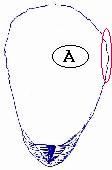 Chipping Side Entry Method
Chipping Side Entry Method
Advantages:
* Very simple. Every culinary oyster type can easily be opened
with this method.
* Ideally suited for large and odd shaped oysters (bananas).
Disadvantages:
* Invariably leads to jagged and unsightly shell damage. Not
recommended for half shell presentation purposes.
* Prone to leave shell splinters in the oyster.
Method
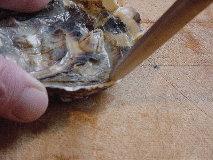 The opening process begins with placing
the oyster on the cutting board and picking the spot on the edge
of the shell considered closest to the suspected location of
the adductor muscle inside. When the "beak" of the
oyster is pointing towards the opener and the cupped part of
the oyster is sitting on the cutting board, the entry point will
always be on the right side of the oyster in the upper quadrant
of the shell.
The opening process begins with placing
the oyster on the cutting board and picking the spot on the edge
of the shell considered closest to the suspected location of
the adductor muscle inside. When the "beak" of the
oyster is pointing towards the opener and the cupped part of
the oyster is sitting on the cutting board, the entry point will
always be on the right side of the oyster in the upper quadrant
of the shell.
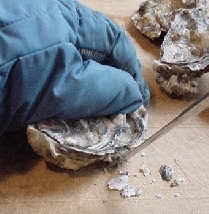 The opener then holds the oyster down firmly with
his gloved hand and starts chipping away at the shell edge by
operating his knife vertically in a gentle stabbing manner. He
(or she) will continue to do so until an opening between the
shell halves leading into the oyster has been achieved. The ultimate
hole should be no larger than the width of the blade.
The opener then holds the oyster down firmly with
his gloved hand and starts chipping away at the shell edge by
operating his knife vertically in a gentle stabbing manner. He
(or she) will continue to do so until an opening between the
shell halves leading into the oyster has been achieved. The ultimate
hole should be no larger than the width of the blade.
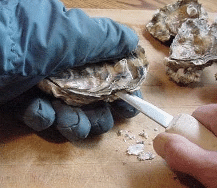 The adductor muscle is located in close proximity
to the hole on the shell edge. It is severed with the gentle
back and forth action of the blade.
The adductor muscle is located in close proximity
to the hole on the shell edge. It is severed with the gentle
back and forth action of the blade.
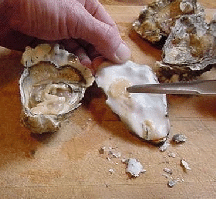 Once the adductor muscle has been severed, the game
is over. All that is left is to bend the top shell back towards
the point of the oyster and snap its last defense, the hinge.
Once the adductor muscle has been severed, the game
is over. All that is left is to bend the top shell back towards
the point of the oyster and snap its last defense, the hinge.
In this picture my knife points to what is left of the adductor
muscle attachment on the top shell. The adductor muscle is still
attached on the cupped shell half. It is thus necessary to gently
slip the tip of the blade under the oyster meat and sever the
base of the adductor muscle from the cupped shell as well. The
meat can now be removed easily.
Note: The oyster I used in this demonstration
looks like it's been through hell. The mantle edges of the meat
are starting to stick to the edge of the shell and the flesh
appears sunken instead of plump. Although the oyster is still
(barely) alive, it has lost much of its moisture due to either
having been stored too long at the seafood market, or having
been stored improperly in transit to or at the seafood market
(i.e. cupped shell portion was stored side-ways or up instead
of down).
Stabbing Side or Front Entry Method
Advantages:
* Very effective in trained hands for proper half shell presentation
of Eastern and European oysters. More demanding with other species.
Disadvantages:
* Not a method for novices. Should be left to experienced
openers.
* Prone to leave some shell splinters in the oyster.
Experienced oyster openers will usually clutch the oyster in
their left hand and seek direct horizontal side entry between
the shell halves with the tip of their oyster knife (without
chipping a hole first). This action can be performed on the left,
front, or right shell margin. I strongly recommend that this
variant be left to the pros and most certainly should be avoided
by any novice! The tip of the oyster knife can easily end up
gliding over, under, or pass through in-between the hard shell
housing and may cause severe injury!
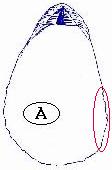 * Side-Knife Method
* Side-Knife Method
The oyster's beak faces away from the opener.This side entry
method then uses the right side of the oyster. Unlike the chipping
side entry described above, where the opener seeks the closest
path to the adductor, this method deviously enters the shell
side margin furthest away from the adductor muscle. It capitalizes
on the oyster's adductor muscle location being more effective
in one hemisphere than the other. Hence, being further removed
from the muscle, the opener benefits from a small top shell leverage
advantage. This method is usually reserved for the Eastern oyster.
Method
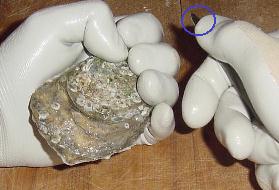 The oyster is
held firmly in the gloved left hand with the cupped side down.
The right thumb (if right handed) is positioned about a 1/4"
away from the point (circled in blue) on one of the flat sides of the (rather dull) knife blade of a classic stabber
style knife (in this demonstration I used a Chesapeake stabber;
see oyster
knives).
The oyster is
held firmly in the gloved left hand with the cupped side down.
The right thumb (if right handed) is positioned about a 1/4"
away from the point (circled in blue) on one of the flat sides of the (rather dull) knife blade of a classic stabber
style knife (in this demonstration I used a Chesapeake stabber;
see oyster
knives).
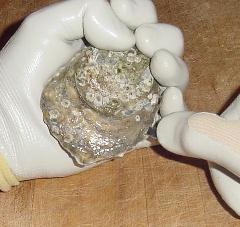 The
gloved right hand brings the blade point to the desired entry point between the shells on the right
side of the oyster, usually somewhere at the midway point between
the beak and "the front" or bill now facing
the opener. The opener has optimal control of the knife
point while wriggling it between the shell halves.
The
gloved right hand brings the blade point to the desired entry point between the shells on the right
side of the oyster, usually somewhere at the midway point between
the beak and "the front" or bill now facing
the opener. The opener has optimal control of the knife
point while wriggling it between the shell halves.
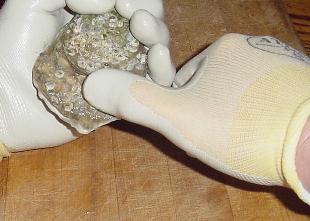 Once
the opener feels that he has gained some entry, his right thumb
shifts on top of the oyster shell and he proceeds to slide the
blade in and across along the underside of the top shell. With
the beak of the oyster facing away, the adductor muscle inside
is located over on the left side. Once the blade is within reach
of the adductor muscle, the adductor is severed with a gentle
back and forth motion of the blade. The right thumb still stays
on the top shell at that point.
Once
the opener feels that he has gained some entry, his right thumb
shifts on top of the oyster shell and he proceeds to slide the
blade in and across along the underside of the top shell. With
the beak of the oyster facing away, the adductor muscle inside
is located over on the left side. Once the blade is within reach
of the adductor muscle, the adductor is severed with a gentle
back and forth motion of the blade. The right thumb still stays
on the top shell at that point.
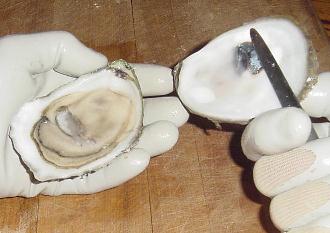 The
right thumb on the top shell now joins the flat side of the blade
inside the oyster like a pincer. In one motion, the top shell
can now be flipped up and back and be pried off easily at the
hinge.
The
right thumb on the top shell now joins the flat side of the blade
inside the oyster like a pincer. In one motion, the top shell
can now be flipped up and back and be pried off easily at the
hinge.
The professional opener will then inspect
the oyster and remove any shell chips that may have snuck in
during opening. From the left he will then gently slide the tip
of his knife under the oyster's flesh and cut the lower part
of the adductor muscle close to the (remaining cupped) shell.
The oyster is now ready to be served on the half shell.
Cutting Side Entry Method
Some European professionals use the sharp blade of their oyster
knives to gain side entry between the shell halves of European
oysters. Although some European experts can also perform this
method on the Pacific oyster, it is particularly difficult due
to the frequently serrated, uneven, and crumbly nature of its
shell edges. The oyster is held in the left hand while the sharp
blade side of the oyster knife is situated on the edge of the
right half of the oyster, about two thirds distance away from
the hinge, precisely where the two shell halves meet. The blade
is wriggled a tad to seat the edge in the shell divide. The knife,
however, is not twisted. The pros will keep their thumb positioned
firmly on the dull blade edge within about a 1/4" of its
tip. This serves to maximize blade control and provides the ability
to apply some moderate pressure. As risky as it sounds (and is!)
in terms of injury, the thumb is also intended as a blade stop
on the shell in case the knife slips. The sharp blade edge is
then slid in to cut the adductor muscle and the flat blade body
simultaneously aids in snapping off the top shell at the hinge
(similar to the finish on the side-knife method described above).
Obviously this method can easily lead to all kinds of injuries
and should most certainly be avoided by any novice!


